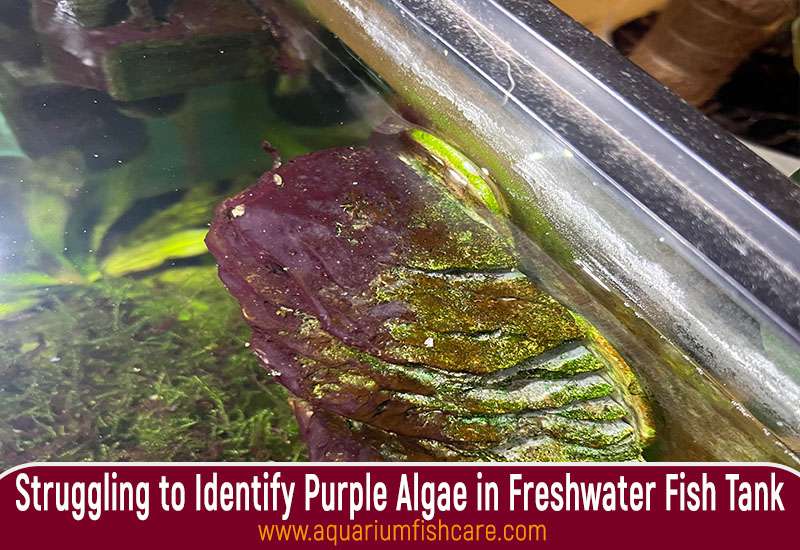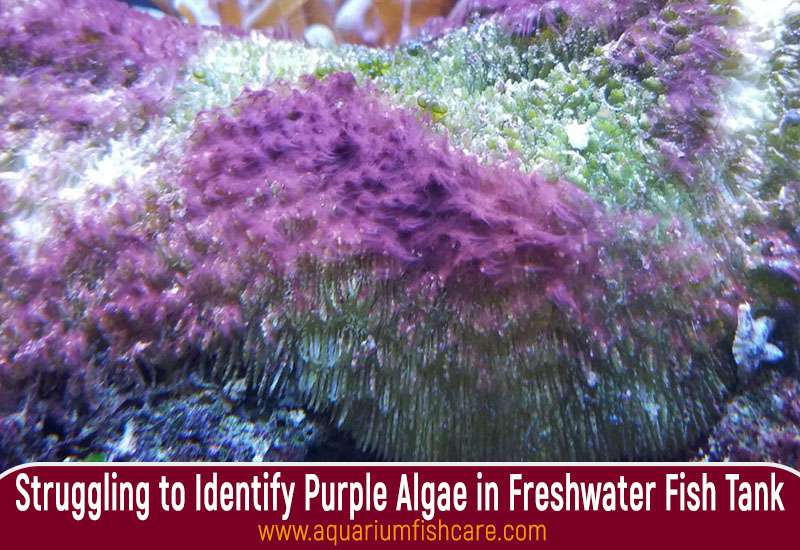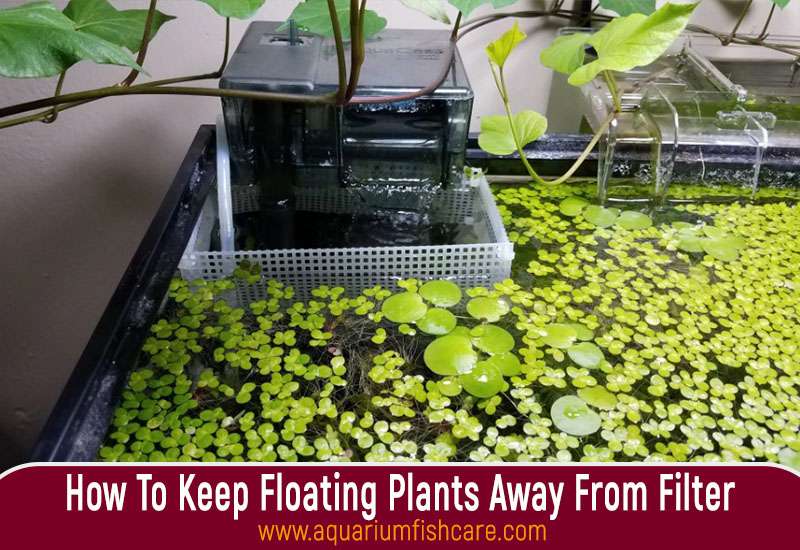Struggling to Identify Purple Algae in Freshwater Fish Tank: Purple algae in a freshwater fish tank can be the result of insufficient water circulation and lighting. To address this issue, reposition the tank to ensure adequate lighting and consider adding an aerator for enhanced water circulation.
Creating a healthy and balanced environment is essential for maintaining a thriving freshwater fish tank. When dealing with purple algae, it’s important to understand the causes and implement effective solutions. We’ll explore the factors contributing to purple algae growth and provide practical tips for its prevention and removal.
By gaining a comprehensive understanding of this issue, you can maintain a clean and vibrant freshwater fish tank for the well-being of your aquatic inhabitants. Let’s delve into the specifics of addressing and preventing purple algae in your freshwater fish tank.

Understanding Purple Algae
Purple algae, commonly known as cyanobacteria, is a type of bacterial algae that can become a nuisance in freshwater fish tanks. Unlike other types of algae, cyanobacteria thrive in low-flow environments with excess nutrients, manifesting as dark purple or blackish patches that can quickly cover tank surfaces. Understanding the identification and common characteristics of purple algae is essential for effective removal and prevention.
Struggling to Identify Purple Algae in Freshwater Fish Tank: Identification Of Purple Algae
To effectively address purple algae issues in a freshwater fish tank, it’s crucial to correctly identify its presence. Commonly referred to as black beard algae, it often appears in hair-like patches with a blackish or purplish appearance. Additionally, it can also manifest as a slippery film resembling sponge algae. Understanding these distinctive visual characteristics aids in prompt recognition and targeted treatment.
Common Characteristics
Purple algae exhibit rapid growth in stagnant water conditions accompanied by elevated nutrient levels. This results in the formation of dark purple or blackish patches, impeding the growth of other aquatic flora in the tank. Furthermore, its slippery and hair-like texture renders it challenging to remove, often requiring meticulous manual extraction to ensure thorough eradication.
Impact On Freshwater Fish Tank
Purple algae in a freshwater fish tank can have a negative impact. This type of algae, also known as black beard algae, can grow in hair-like patches and be tricky to remove. Manual removal and a well-planted tank can help combat this pesky algae.
Potential Harm To Fish
Purple algae can harm freshwater fish by depleting oxygen levels, causing stress, and leading to diseases.
Aesthetic Disruption
Purple algae can disrupt the aesthetics of a freshwater fish tank by creating an unsightly appearance and affecting the overall visual appeal.
Effective Removal Methods
Purple algae, also known as cyanobacteria or black beard algae, can be a persistent nuisance in freshwater fish tanks. This slippery alga has a blackish or purplish appearance and tends to grow in hair-like patches, making it difficult to remove. However, there are several effective methods to control and eliminate purple algae in your aquarium.

Manual Removal Techniques
One of the best ways to combat purple algae is through manual removal. This involves physically removing the algae from your tank using tools such as a siphon or algae scraper. Regularly clean your tank, focusing on areas where the algae tends to accumulate, such as the substrate, decorations, and glass walls. By manually removing the algae, you can reduce its population and prevent further growth.
Nutrient Control And Plant Density
To effectively control purple algae, it is important to address the underlying causes. Cyanobacteria thrive in nutrient-rich environments, so it is crucial to control the nutrient levels in your tank. Implement proper feeding practices by avoiding overfeeding and removing any excess food that remains uneaten. Additionally, consider increasing the density of live aquatic plants in your aquarium.
Aquatic plants act as natural competitors for nutrients, effectively starving the algae and limiting its growth. Choose fast-growing plants such as Java moss, Hornwort, or Anacharis, as they can quickly absorb excess nutrients and outcompete the algae. Maintaining a well-balanced ecosystem with a healthy plant density will help prevent the reoccurrence of purple algae in your freshwater fish tank.
Specific Challenges Of Purple Algae
Purple algae can pose specific challenges in freshwater fish tanks. This type of algae has a blackish or purplish appearance and can grow in hair-like patches, making it difficult to remove. It is important to properly identify and address purple algae to maintain a healthy tank environment for your fish.
Adaptability To Tank Environments
Purple algae, also known as cyanobacteria, can be a specific challenge in freshwater fish tanks due to its adaptability to various tank environments. This type of algae can thrive and flourish in a range of conditions, making it difficult to eradicate. Unlike other algae types that require specific lighting or nutrient levels, purple algae can grow in both low and high-light conditions, and it can also withstand fluctuations in nutrient availability.
Resilience And Growth Factors
One of the reasons purple algae is a persistent problem in freshwater fish tanks is its resilience and growth factors. This type of algae can reproduce rapidly, forming slimy colonies that can quickly cover tank surfaces. Additionally, purple algae is known for its ability to withstand harsh conditions and adapt to different water parameters, including temperature fluctuations and water chemistry variations.
This adaptability allows the algae to survive and grow, even in tanks where other algae species struggle. To control the growth of purple algae in your freshwater fish tank, it is essential to combine various strategies. Manual removal of visible algae colonies, regular water changes, and proper tank maintenance are crucial steps in keeping the algae under control.
Additionally, creating a balanced and stable environment for your fish and plants can help prevent the excessive growth of purple algae. By addressing the specific challenges associated with purple algae, fish tank enthusiasts can maintain a healthy and visually appealing aquarium.
Preventive Measures To Avoid Recurrence
Dealing with purple algae in a freshwater fish tank can be challenging, but implementing preventive measures is key to avoiding its recurrence. By optimizing tank conditions and adhering to regular maintenance practices, you can effectively control and prevent the growth of purple algae.
Optimizing Tank Conditions
- Proper Lighting: Ensure the tank receives adequate light but avoid excess sunlight exposure.
- Nutrient Control: Monitor and regulate nutrient levels in the water to prevent algae overgrowth.
- Water Quality: Maintain proper water parameters such as pH, temperature, and hardness to create a healthy environment.
- Aquatic Plants: Introduce live plants that can outcompete algae for nutrients, helping to inhibit algae growth.
Regular Maintenance Practices
- Water Changes: Perform regular water changes to remove excess nutrients and waste from the tank.
- Algae Scrubbing: Regularly clean the tank walls and decorations to prevent algae buildup.
- Filter Maintenance: Clean or replace filters as needed to maintain proper filtration efficiency.
- Fish Feeding: Avoid overfeeding fish, as uneaten food can contribute to algae growth.
By following these preventive measures consistently, you can create a balanced ecosystem in your freshwater fish tank and mitigate the risk of purple algae recurrence. Remember, proactive maintenance is key to keeping your tank healthy and free from unwanted algae.
Expert Insights And Recommendations
Expert insights and recommendations for dealing with purple algae in a freshwater fish tank include manual removal and adding more plants to outcompete the algae for nutrients. This type of algae, often called Black Beard algae, is challenging to remove and can grow in hair-like patches, so it’s important to take proactive measures to control its spread.
Nutrient Levels And Control
High nutrient levels can trigger purple algae growth in freshwater tanks. Monitor and control nutrient inputs to prevent this issue.
Introducing Natural Predators
Consider adding snails or algae-eating fish as natural predators of purple algae. These organisms can help combat algae growth in your tank.
Community Advice And Experiences
Community advice and experiences play a crucial role in understanding and effectively addressing the issue of purple algae in freshwater fish tanks. Learning from fellow fish keepers who have encountered similar challenges can provide valuable insights and practical solutions.
Engaging With Fellow Fish Keepers
Engaging with fellow fish keepers can offer a wealth of knowledge and practical tips for tackling purple algae in freshwater tanks. Online forums, social media groups, and local fish-keeping communities are excellent platforms for seeking advice, sharing experiences, and exchanging ideas on effective algae control methods.
Successful Case Studies
Exploring successful case studies of fish keepers who have effectively managed and eliminated purple algae in their freshwater tanks can provide invaluable guidance. By learning from real-life experiences and documented success stories, fish keepers can gain practical insights into the most effective strategies for combating this persistent issue.
Frequently Asked Questions On Purple Algae In Freshwater Fish Tank
How Do I Get Rid Of Purple Algae In My Aquarium?
The best way to get rid of purple algae in your aquarium is through manual removal and ensuring a well-planted environment to reduce nutrient levels.
What Is The Purple Slime In My Freshwater Aquarium?
Purple slime in your freshwater aquarium is likely Black Beard algae, which is difficult to remove. It appears blackish or purplish and grows in hair-like patches resembling a beard.
What Is The Purple Film In My Fish Tank?
The purple film in your fish tank is most likely purple algae, also known as sponge algae or Pink Cotton Candy algae. It can cover surfaces such as live rock, glass, and power heads. It is difficult to remove and can grow between the polyps of corals.
One way to control it is by manually removing it and ensuring there are enough plants in the tank to starve it.
How Do I Get Rid Of Algae Blooms In My Freshwater Tank?
To get rid of algae blooms in your freshwater tank, manually remove the algae and ensure you have plenty of plants to starve it. Additionally, you can install an ultraviolet sterilizer to eliminate suspended algae and disease-causing organisms, resulting in crystal-clear water.
Remember, purple algae may require specific nutrients or minerals to thrive, so monitor your tank’s conditions closely.
What Causes Purple Algae In Freshwater Tanks?
Purple algae, known as Black Beard algae, thrives in unbalanced tank conditions, growing in hair-like patches.
How Do I Identify Purple Slime In My Aquarium?
Purple slime, or Black Beard algae, has a blackish or purplish appearance and resembles a beard in patches.
Is Purple Film Harmful To Fish In The Tank?
The purple film, also known as sponge algae, can cover tank surfaces and corals, being challenging to remove.
Conclusion
Dealing with purple algae in your freshwater fish tank can be challenging, but with proper methods like manual removal and nutrient management, you can maintain a healthy aquarium. Remember, identifying the root cause is essential for effective prevention and treatment.
Keep your tank balanced and enjoy a thriving aquatic environment.


